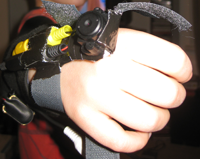Third Eye
What is it like to have an eye or eyes in the back of your head? If you had an extra eye would you want it to always face backwards or forwards, or would it be better if you could move it around? These are some of the questions motivating the development of the the Third Eye prototype. We are attaching an ultra mini CMOS camera to a ring so it can be worn on a finger and moved around. The image from this camera is converted into stimulation on a vibrotactile array. A key question that we are exploring is how the image should be mapped to vibration - should it be like peripheral vision and primarily sensitive to motion, for example?

